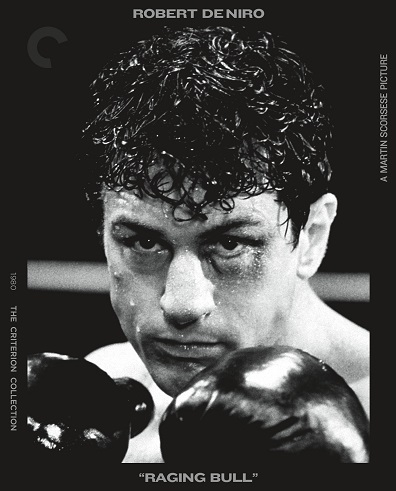
Raging Bull
Studio: The Criterion Collection
Aug 18, 2022
Web Exclusive
![]()
Even by the standards of famous directors, it’s amazing how relevant Martin Scorsese has remained almost half a century after he burst out of the New Hollywood scene of the 1970s with films like Mean Streets and Taxi Driver. In addition to doing some of his most vital and incisive work over the past decade - The Wolf of Wall Street, Silence, The Irishman - he’s also maintained a steady presence in the zeitgeist, mostly by pissing off Marvel fans by saying that their entertainment of choice are theme park rides rather than cinema, as well as decrying the increasingly corporate nature of filmmaking in the 21st century. Raging Bull, Scorsese’s 1980 masterpiece and his fourth of nine (and counting) collaborations with lead actor/muse Robert De Niro, is precisely the kind of artistic effort that modern audiences would not accept and modern studios would not fund.
The brute of the title, Jake LaMotta was a real life boxer who was the world middleweight champion from 1949 to 1951. Raging Bull depicts his life from 1941 to 1964, chronicling his rise from the Bronx streets to his sad end in Miami performing spoken word comedy routines at cheap nightclubs. Although the real Jake Lamotta lived until 2017, Scorsese’s 23 year snapshot feels like a complete picture of a life poorly lived. Scorsese gets a lot of flack for his warts-and-all depictions of criminal life and toxic masculinity. From Travis Bickle to Henry Hill to Jordan Belfort, he has an affinity for and a deep understanding of terrible men doing terrible things. But while many of his films use humor as an access point to worlds of moral bankruptcy - Goodfellas and The Wolf of Wall Street are funnier than most movies classified as comedies - Raging Bull features little in the way of levity. Shot in stark black and white - courtesy of Scorsese’s early recurring cinematographer Michael Balhaus - and set amid the drab apartment buildings and locker rooms of mid-century New York, the film isn’t nearly as charming or inviting as Scorsese’s other films about bad men doing bad things.
At the film’s center is Robert De Niro’s performance as LaMotta, which won him his only Oscar for Best Actor. Much is made of the physical transformation De Niro went through - morphing from shredded heavyweight champ to bloated, middle-aged wreck. Impressive as that all is, De Niro is able to provide a glimpse of La Motta’s entire character in just his opening scene with Joe Pesci, playing LaMotta’s brother. Talking over a small table in LaMotta’s crummy Bronx apartment, he’s by turns a playful bully, a prideful warrior and a jealous monster. LaMotta’s ticket to success is what will ultimately destroy him; a single-minded obsession with bending everything in front of him to his own impotent will. It’s arguably the darkest character De Niro has ever played and possibly the most doomed protagonist in any of Scorsese’s films.
(www.criterion.com/films/29158-raging-bull)
Current Issue

Issue #72
Apr 19, 2024 Issue #72 - The ‘90s Issue with The Cardigans and Thurston Moore
Most Recent
- Under the Radar Announces The ’90s Issue with The Cardigans and Thurston Moore on the Covers (News) — The Cardigans, Thurston Moore, Sonic Youth, Garbage, The Cranberries, Pavement, Lisa Loeb, Supergrass, Spiritualized, Lush, Miki Berenyi, Miki Berenyi Trio, Emma Anderson, Hatchie, Ride, Slowdive, Velocity Girl, Penelope Spheeris, Terry Gilliam, Gus Van Sant, Ron Underwood, Kula Shaker, Salad, Foals, Semisonic, The Boo Radleys, Stereo MC’s, Pale Saints, Blonde Redhead, Sleater-Kinney, Cocteau Twins, Lucy Dacus, Alex Lahey, Horsegirl, Grandaddy, alt-J, Squid, The Natvral, Wolf Alice, Jess Williamson, Sunflower Bean, Orville Peck, Joel McHale
- 10 Best Songs of the Week: Fontaines D.C., Cassandra Jenkins, Loma, John Grant, and More (News) — Songs of the Week, Fontaines D.C., Cassandra Jenkins, Loma, John Grant, Good Looks, Hana Vu, Belle and Sebastian, Yannis & The Yaw, Strand of Oaks, Home Counties
- Fresh Shares New EP ‘Merch Girl’ (News) — Fresh
- Premiere: LOVECOLOR Shares New Video for “Crazy Love” (News) — LOVECOLOR
- Final Summer (Review) — Cloud Nothings

Comments
Submit your comment
There are no comments for this entry yet.